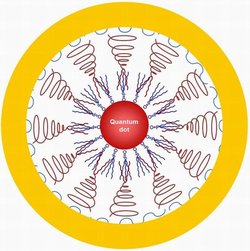The first-ever structure that provides a multi-purpose nanotechnology means for both medical imaging and healing simultaneously was developed at the University of Washington

Today, nanoparticles are being developed for a wide variety of medical uses - tumor imaging, drug transport and spot heat irradiation. Instead of settling for each of them separately, researchers at the University of Washington merged two types of nanoparticles into one tiny substance. The result is the first ever structure that provides a multipurpose nanotechnological means for both medical imaging and healing, simultaneously. The structure is described in an article recently published in the scientific journal Nature Nanotechnology.
"This is the first time that semiconductor and metallic nanoparticles have been combined in a way that preserves the separate function of each of the different components," noted lead author Bioengineering Professor Xiaohu Gao.
The current focus is on medical applications, but the researchers explained that such multifunctional nanoparticles could also be used in other areas such as energy research for the development of solar cells.
Quantum dots are radiating spheres (fluorescence) of a semiconductor material with a diameter of only a few nanometers - a small fraction of the wavelength of visible light. At this tiny scale, the unique optical properties of quantum dots allow them to emit light in different colors depending on their size. Quantum dots are being developed for medical imaging, solar cells and light emitting diodes.
Luminous gold particles were still used in ancient times in colored glass; Recently, their use has been promoted to transport drugs, treat arthritis and medical imaging using infrared radiation. Gold also re-radiates heat and thanks to this can be used in the medical treatment of spot heat radiation on unhealthy cells.
However, if you merge a quantum dot with a nanoparticle, these properties disappear. The electric fields of the two types of particles interfere with each other and neither behaves normally. Both types have been successfully combined on a surface in the past, but never in one particle.
The article describes a production method that uses proteins to coat a quantum dot core with a thin gold layer three nanometers away from it, so that the electric and optical fields of the two different components do not interfere with each other. It is likely that the quantum dot will be used for fluorescence imaging. The gold sphere could be used for scattering-based imaging, which has advantages over fluorescence imaging in certain circumstances, as well as for medical heat transport.
The newly developed production method is general and can also be adapted to other nanoparticle combinations, the researchers note. "We chose a serious challenge," says the lead researcher. "It is well known that gold, or any other metal, will dampen the radiation of a quantum dot, thereby essentially eliminating its purpose."
The researchers overcame this problem by inserting a thin layer of gold that wraps around the quantum dot, but never actually touches it. They carefully controlled the spacing between the gold layer and the nanoparticle core through the use of polyethylene glycol polymer chains. The distance between the core of the quantum dot and the charged gold ion is determined according to the length of the polymer chain and can increase with nanometric precision by adding structural units to the chain. To the outer layer they added short amino acids (poly-histidines) that bind to the charged gold atoms. The lead researcher compares the entire structure to a golden egg, where the quantum dot is the yolk, the gold is the shell and the polymers fill the space between them, similar to egg white.
The use of ions allowed the researchers to prepare a layer of gold two to three nanometers thick, which is thin enough to allow half of the quantum dot's fluorescence to pass through. "All existing methods use gold nanoparticles instead of gold ions," notes the researcher. "Gold nanoparticles are three to five nanometers in diameter, and with the addition of natural "roughness" the thinnest layer you can reach is five to six nanometers in diameter. Golden doves are much, much smaller." The total diameter of the integrated particle is approximately fifteen to twenty nanometers, and it is small enough to be able to penetrate the inside of a biological cell.
The combination of gold atoms (or ions) provides sufficiently reliable binding sites for the attachment of biological particles that are being prepared towards certain cells, such as cancer cells. The gold would also be able to increase the radiation of the quantum dot five to ten times more, as has been observed in other cases in the past. The gold layer provides another advantage - gold does not harm the body, is approved for medical use and does not break down over time in the body; Therefore, a gold shell could provide a stable and non-toxic "container" for nanoparticles used in the body, adds the lead researcher.

3 תגובות
Hey,
I wanted to interest you in the exit'09 competition.
This is a competition in which for 4 weeks each person can come up with a 60 second idea in a video and the surfers vote which idea is the best.
Each week a winner will be chosen and from all of them we will take two, we will develop the idea for them during an intensive week into a product (and everything will be transmitted live on the Internet) and the products will be presented at themarker's in-novation09 conference. We currently have two winners out of eight potential places and new ideas can be submitted in the next two weeks
The winner receives a prize package worth $250,000 that includes development, branding, business development, hardware legal advice and more
This week is the last week for submitting offers. hurry up
http://www.exit2009.com
I read a lot about nanospheres or nanocapsules as cancer drugs,
I'm curious how long it takes for these developments to mature into real drugs that work?
Let's buy gold ;)